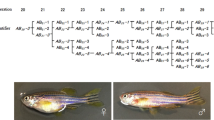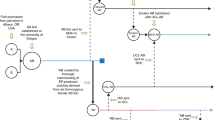Abstract
Genetically homogeneous populations such as inbred strains are valuable experimental tools in various fields of biomedical analyses. In many animals, inbred strains are established by consecutive sib-pair mating for a minimum of 20 generations. As the generation proceeds, fitness of the population reduces usually. Therefore, in order to establish inbred strains, the important point is the selection of pairs in good condition at each generation. Here, I describe the procedure and tips for generating inbred strains in zebrafish.
Access this chapter
Tax calculation will be finalised at checkout
Purchases are for personal use only
Similar content being viewed by others
References
Kimura T, Shimada A, Sakai N et al (2007) Genetic analysis of craniofacial traits in the medaka. Genetics 177:2379–2388
Frankel WN (1995) Taking stock of complex trait genetics in mice. Trends Genet 11:471–477
Naruse K, Hori H, Shimizu N et al (2004) Medaka genomics: a bridge between mutant phenotype and gene function. Mech Dev 121:619–628
Peters LL, Robledo RF, Bult CJ et al (2007) The mouse as a model for human biology: a resource guide for complex trait analysis. Nat Rev Genet 8:58–69
Falconer DS (1989) Introduction to quantitative genetics. Longman, Essex, UK
Shinya M, Sakai N (2011) Generation of highly homogeneous strains of zebrafish through full sib-pair mating. G3 (Bethesda) 1:377–386
Westerfield M (1993) The zebrafish book: a guide for the laboratory use of zebrafish (Danio rerio). University of Oregon Press, Eugene, OR
Koshida S, Shinya M, Mizuno T et al (1998) Initial anteroposterior pattern of the zebrafish central nervous system is determined by differential competence of the epiblast. Development 125:1957–1966
Hyodo-Taguchi Y, Egami N (1985) Establishment of inbred strains of the medaka Oryzias latipes and the usefulness of the strains for biomedical research. Zoolog Sci 2:305–316
Wilson CA, High SK, McCluskey BM et al (2014) Wild sex in zebrafish: loss of the natural sex determinant in domesticated strains. Genetics 198:1291–1308
Acknowledgment
I thank Dr. Noriyoshi Sakai and his lab members in the National Institute of Genetics for their valuable assistance in breeding zebrafish. I am also grateful to Ms. Hideko Utsumi, Dr. Taijiro Yabe, and Prof. Shinji Takada for their kind support in the maintenance of the IM strain and Drs. Atsuko Shimada, Kiyoshi Naruse, Yasuhiro Kamei, Tomonori Deguchi, and Koichi Kawakami for their helpful support and discussions. The work was supported partly by Grant-in-Aid for Young Scientists (B) from Japan Society for the Promotion of Science, by the Center for the Promotion of Integrated Sciences (CPIS) of Sokendai, and by NIBB Collaborative Research Program (c-12-351, b-13-202).
Author information
Authors and Affiliations
Corresponding author
Editor information
Editors and Affiliations
Rights and permissions
Copyright information
© 2016 Springer Science+Business Media New York
About this protocol
Cite this protocol
Shinya, M. (2016). Construction of the Inbred Strain. In: Kawakami, K., Patton, E., Orger, M. (eds) Zebrafish. Methods in Molecular Biology, vol 1451. Humana Press, New York, NY. https://doi.org/10.1007/978-1-4939-3771-4_8
Download citation
DOI: https://doi.org/10.1007/978-1-4939-3771-4_8
Published:
Publisher Name: Humana Press, New York, NY
Print ISBN: 978-1-4939-3769-1
Online ISBN: 978-1-4939-3771-4
eBook Packages: Springer Protocols




